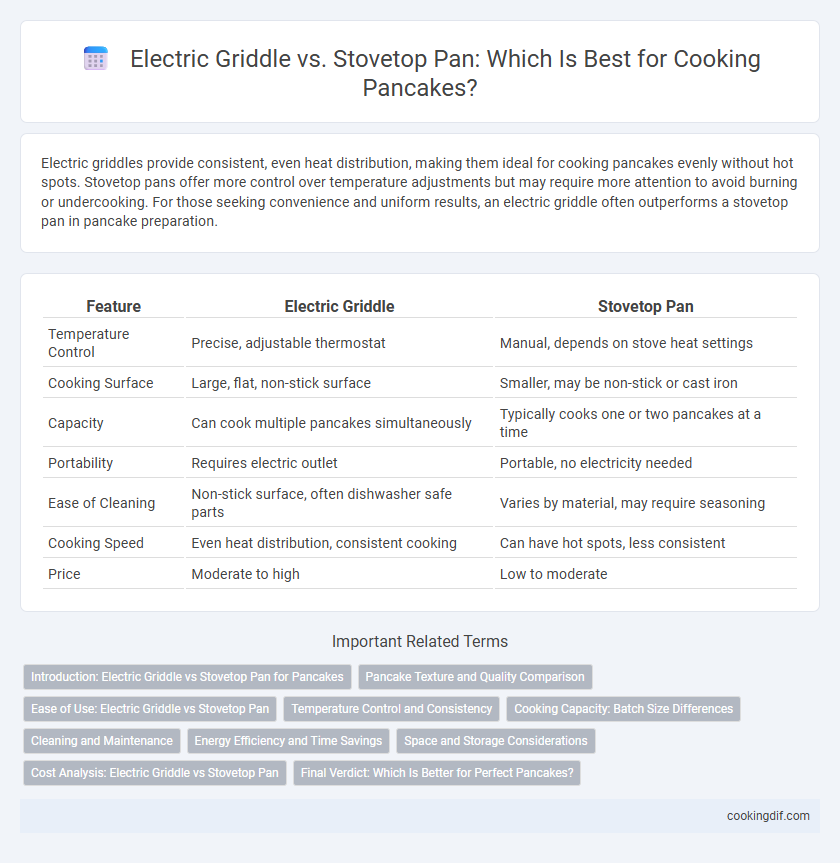Electric griddles provide consistent, even heat distribution, making them ideal for cooking pancakes evenly without hot spots. Stovetop pans offer more control over temperature adjustments but may require more attention to avoid burning or undercooking. For those seeking convenience and uniform results, an electric griddle often outperforms a stovetop pan in pancake preparation.
Table of Comparison
| Feature | Electric Griddle | Stovetop Pan |
|---|---|---|
| Temperature Control | Precise, adjustable thermostat | Manual, depends on stove heat settings |
| Cooking Surface | Large, flat, non-stick surface | Smaller, may be non-stick or cast iron |
| Capacity | Can cook multiple pancakes simultaneously | Typically cooks one or two pancakes at a time |
| Portability | Requires electric outlet | Portable, no electricity needed |
| Ease of Cleaning | Non-stick surface, often dishwasher safe parts | Varies by material, may require seasoning |
| Cooking Speed | Even heat distribution, consistent cooking | Can have hot spots, less consistent |
| Price | Moderate to high | Low to moderate |
Introduction: Electric Griddle vs Stovetop Pan for Pancakes
Electric griddles offer consistent temperature control and a large, flat cooking surface ideal for making multiple pancakes evenly and quickly. Stovetop pans provide versatility with different sizes and shapes but require more attention to heat management to avoid uneven cooking. Choosing between an electric griddle and stovetop pan depends on pancake quantity, desired cooking speed, and temperature precision.
Pancake Texture and Quality Comparison
Electric griddles distribute heat evenly across a larger surface, yielding pancakes with a consistent golden-brown crust and fluffy interior, enhancing overall texture uniformity. Stovetop pans often create hot spots leading to uneven cooking, which can result in pancakes with inconsistent browning and a denser texture. For optimal pancake quality, electric griddles provide stable temperature control that preserves moisture and produces tender, perfectly cooked pancakes.
Ease of Use: Electric Griddle vs Stovetop Pan
Electric griddles offer precise temperature control and a larger, flat cooking surface, making it easier to cook multiple pancakes evenly and consistently. Stovetop pans require manual temperature adjustments and often have a smaller surface area, which can result in uneven cooking and more frequent flipping. The electric griddle's interface simplifies the cooking process, reducing the likelihood of burning or undercooking pancakes compared to traditional stovetop pans.
Temperature Control and Consistency
Electric griddles offer precise temperature control with adjustable thermostats, ensuring uniform heat distribution for perfectly cooked pancakes every time. Stovetop pans often have hot spots and uneven heat, requiring more attention to maintain consistent cooking temperatures. Consistency in pancake texture and browning is easier to achieve on an electric griddle due to its stable surface temperature and larger cooking area.
Cooking Capacity: Batch Size Differences
Electric griddles offer larger cooking surfaces, allowing multiple pancakes to be cooked simultaneously, significantly increasing batch size compared to stovetop pans. Stovetop pans typically accommodate fewer pancakes at once, limiting cooking capacity and requiring multiple batches. For families or gatherings, electric griddles enhance efficiency by handling high pancake volumes in less time.
Cleaning and Maintenance
Electric griddles feature non-stick surfaces that simplify cleaning, requiring only a quick wipe-down after cooking, while stovetop pans often demand more thorough scrubbing due to residue buildup. Many electric griddles have removable plates, enhancing ease of maintenance compared to fixed stovetop pans. Regular seasoning and proper drying are essential for stovetop pans to prevent rust and maintain performance, whereas electric griddles typically need less upkeep.
Energy Efficiency and Time Savings
Electric griddles consume less energy by maintaining consistent heat and cooking multiple pancakes simultaneously, resulting in significant time savings compared to stovetop pans. Stovetop pans often require frequent temperature adjustments and batch cooking, increasing overall cooking time and energy use. Choosing an electric griddle enhances energy efficiency and streamlines pancake preparation by reducing cooking duration.
Space and Storage Considerations
Electric griddles offer a larger, flat cooking surface ideal for making multiple pancakes simultaneously, but they require dedicated counter or storage space due to their bulky size. Stovetop pans are generally more compact and easier to store, fitting into standard kitchen cabinets or drawers with minimal space. Choosing between the two depends on available kitchen space and storage capacity, with electric griddles favored for high-volume cooking and stovetop pans preferred for space-saving convenience.
Cost Analysis: Electric Griddle vs Stovetop Pan
Electric griddles typically range from $30 to $100, offering consistent heat distribution and larger cooking surfaces that can increase pancake batch size efficiency. Stovetop pans are generally less expensive, costing between $15 and $50, but may require more skill to maintain even heat, potentially affecting cooking time and fuel consumption costs. Considering electricity versus gas usage, electric griddles may incur higher energy expenses, while stovetop pans rely on variable fuel costs depending on the stove type.
Final Verdict: Which Is Better for Perfect Pancakes?
Electric griddles offer consistent heat distribution and larger cooking surface, ensuring evenly cooked pancakes with ideal golden-brown texture. Stovetop pans provide greater control over temperature but often result in uneven heat, making it harder to achieve uniform pancakes. For perfect pancakes, electric griddles are generally better due to their convenience, precise temperature control, and ability to cook multiple pancakes simultaneously.
Electric griddle vs stovetop pan for pancake cooking Infographic

 cookingdif.com
cookingdif.com